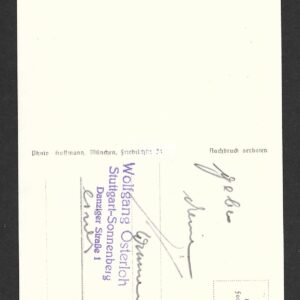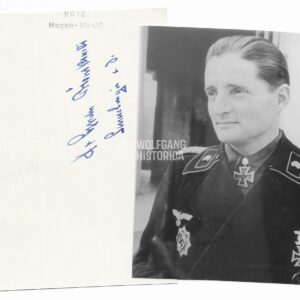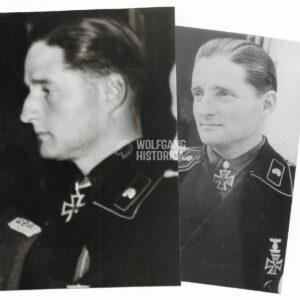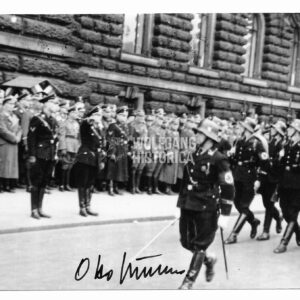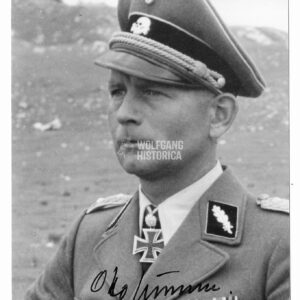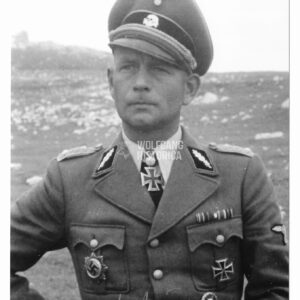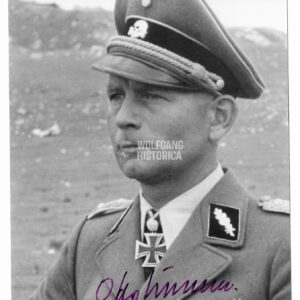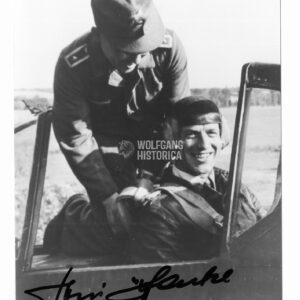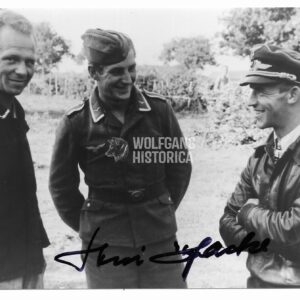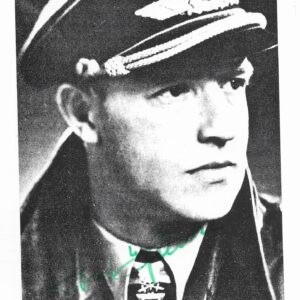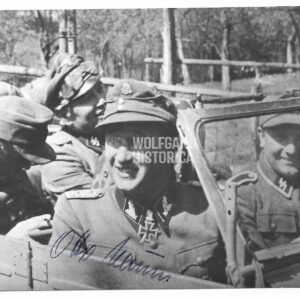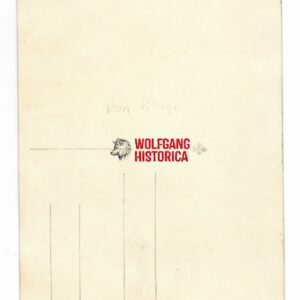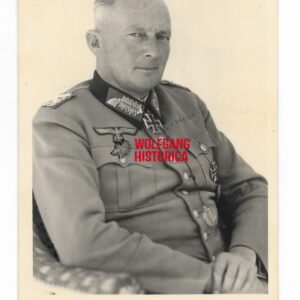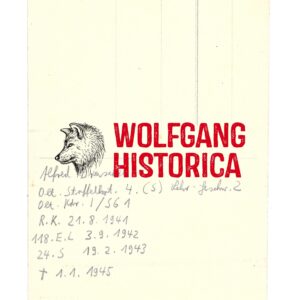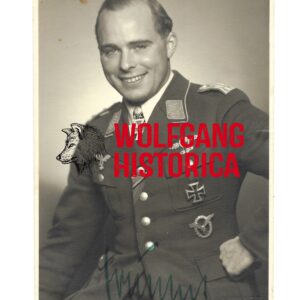Günther Lützow – Jagdgeschwader 3 (Schwertern) (Wartime Signed)
€395,00Original Wartime Signature on a Postcard of Günther "Franzl" Lützow. Oberst Günther Lützow (04.09.1912 † 24.04.1945) earned the Ritterkreuz des Eisernen Kreuzes on September 28, 1940, the Eichenlaub on July 20, 1941 & the Schwertern on October 11, 1941 as Major und Kommodore of the Jagdgeschwader 3. Condition as seen.
In April 1945, he joined Galland's Jagdverband 44 (JV 44—44th Fighter Detachment). He was reported missing in action flying the Me 262 on 24 April 1945 while attempting to intercept a U.S. Army Air Forces B-26 Marauder raid near Donauwörth. His body was never recovered.
Hermann Hogeback – Lehrgeschwader 1 & Kampfgeschwader 6 (Schwertern)
€0,01Major Erich Rudorffer – Jagdgeschwader 2 & 54 (Schwertern, 224 Victories!)
€0,01Major Erich Rudorffer – Jagdgeschwader 2 & 54 (Schwertern, 224 Victories!)
€0,01Johannes Steinhoff – Jagdgeschwader 52 & 77 (Schwertern, 176 Victories!) (Large Size)
€75,00Johannes Steinhoff achieved 176 victories during the Second World War. He also flew the Me 262!
Provenance: This signature comes from one of the largest postwar signature collection I’ve ever commissioned. This collection was started by a Waffen-SS Veteran, Werner H., in the 1950’s until he passed away.
Heinz-Georg Lemm – Füsilier-Regiment 27 (Ardennes) (Schwertern)
€45,00Günther Rall – Jagdgeschwader 52 (Schwertern, 275 Victories!) (Large Size!)
€60,00Günther Rall – Jagdgeschwader 52 (Schwertern, 275 Victories!) (Large Size!)
€60,00Günther Rall – Jagdgeschwader 52 (Schwertern, 275 Victories!) (Large Size!)
€60,00Heinz Harmel – “Deutschland” & “Frundsberg” (Schwertern) (Normandy, Nijmegen) (Large Size!)
€120,00Arthur Jüttner – Grenadier-Regiment 532 & 164 (Schwertern)
€35,00Werner Ziegler – Grenadier-Regiment 186 (Schwertern)
€0,01Karl Thieme – Panzergrenadier-Regiment 110 & 111 (Schwertern)
€0,01Hermann von Oppeln-Bronikowski – Panzer-Regiment 22, 204 & 20. Panzer-Division (Schwertern) (Normandy)
€0,01Friedrich Lang – Sturzkampfgeschwader 2 & Schlachtgeschwader 1 (Schwertern)
€35,00Otto Kumm – Regiment “Der Führer” & Division “Prinz Eugen” (Schwertern)
€70,00Otto Kumm – Regiment “Der Führer” & Division “Prinz Eugen” (Schwertern)
€0,01Otto Kumm – Regiment “Der Führer” & Division “Prinz Eugen” (Schwertern)
€0,01Otto Kumm – Regiment “Der Führer” & Division “Prinz Eugen” (Schwertern)
€70,00Otto Kumm – Regiment “Der Führer” & Division “Prinz Eugen” (Schwertern)
€0,01Otto Kumm – Regiment “Der Führer” & Division “Prinz Eugen” (Schwertern)
€70,00Sylvester Stadler – “Der Führer” & “Hohenstaufen” (Schwertern + NKIG)
€60,00Sylvester Stadler – “Der Führer” & “Hohenstaufen” (Schwertern + NKIG)
€60,00Sylvester Stadler – “Der Führer” & “Hohenstaufen” (Schwertern + NKIG)
€0,01Sylvester Stadler – “Der Führer” & “Hohenstaufen” (Schwertern + NKIG)
€0,01Sylvester Stadler – “Der Führer” & “Hohenstaufen” (Schwertern + NKIG)
€60,00Sylvester Stadler – “Der Führer” & “Hohenstaufen” (Schwertern + NKIG)
€0,01Anton Hackl – Jagdgeschwader 77 & 11 (Schwertern, 192 Victories!)
€0,01Anton Hackl – Jagdgeschwader 77 & 11 (Schwertern, 192 Victories!)
€0,01Anton Hackl – Jagdgeschwader 77 & 11 (Schwertern, 192 Victories!)
€75,00Anton Hackl – Jagdgeschwader 77 & 11 (Schwertern, 192 Victories!)
€75,00Otto Baum – “Totenkopf” & “Das Reich” (Schwertern)
€0,01Wilhelm Batz – Jagdgeschwader 52 (Schwertern, 237 Victories!)
€0,01Wilhelm Batz – Jagdgeschwader 52 (Schwertern, 237 Victories!)
€0,01Wilhelm Batz – Jagdgeschwader 52 (Schwertern, 237 Victories!)
€0,01Wilhelm Batz – Jagdgeschwader 52 (Schwertern, 237 Victories!)
€0,00Wilhelm Batz – Jagdgeschwader 52 (Schwertern, 237 Victories!)
€0,01Wilhelm Batz – Jagdgeschwader 52 (Schwertern, 237 Victories!)
€45,00Studioportrait of Generalfeldmarschall Günther von Kluge (Schwertern, July 20 Plot, Committed Suicide)
€0,01Original Wartime Studioportrait of Günther von Kluge. Generalfeldmarschall Günther von Kluge (30.10.1882 in Posen † 19.08.1944 in Metz, France) earned the Ritterkreuz des Eisernen Kreuzes on September 30, 1939 as General der Artillerie und Kommandeur of the 4. Armee, the Eichenlaub on January 18, 1943 as Generalfeldmarschall und Oberbefehlshaber of the Heeresgruppe Mitte and the Schwertern on March 30, 1944 as Generalfeldmarschall und Oberbefehlshaber of the Heeresgruppe Mitte. Good condition. Postcardsize.
Read more about Günther von KlugeAlfred Druschel – Schlachtgeschwader 1 (Stalingrad, Schwertern) (Wartime Signed) (MIA 1945)
€0,01Original Wartime Signature on a Studioportrait of Alfred Druschel. Oberst Alfred Druschel (04.02.1917 † Missing in Action 01.01.1945) earned the Ritterkreuz on August 21, 1941 as Oberleutnant und Staffelkapitän of the 2. Staffel/ Lehrgeschwader 2, the Eichenlaub on September 3, 1942 as Hauptmann und Kommandeur of the I. Gruppe/ Schlachtgeschwader 1 and the Schwertern on February 19, 1943 as Hauptmann und Kommandeur of the I. Gruppe/ Schlachtgeschwader 1. Good condition. Edges have been cut.
Eichenlaub: “Awarded for further individual and command achievements during operations at Kertsch, Sevastopol and the Caucasus. By this time he had flown over 600 sorties. A particularly notable success took place on the 12.06.1942 when he destroyed an ammunition train along the Kharkov-Kupyansk railway (about 60 km ESE of Kharkov itself).”
Schwertern: “Awarded for his flying over 700 sorties as well as the great successes of his Gruppe at Voronezh, Rostov, along the Don and at Stalingrad.” (via Tracesofwar)Günther-Eberhardt Wisliceny – SS-Panzergrenadier-Regiment 3 “Deutschland” (Schwertern & NKIG)
€0,01Original Scarce Postwar Signature on a Postwar Photo of Günther-Eberhardt Wisliceny. SS-Obersturmbannführer Günther-Eberhardt Wisliceny (05.09.1912 † 25.08.1985) earned the Ritterkreuz on July 30, 1943 as SS-Sturmbannführer und Kommandeur of the III. Bataillon/ SS-Panzer-Grenadier-Regiment 3 “Deutschland”, the Eichenlaub on December 26, 1944 as SS-Obersturmbannführer und Kommandeur of the SS-Panzer-Grenadier-Regiment 3 “Deutschland”, the Nahkampfspange in Gold on March 31, 1945 with the SS-Panzer-Grenadier-Regiment 3 “Deutschland” and the Schwertern on May 6, 1945 as SS-Obersturmbannführer und Kommandeur of the SS-Panzer-Grenadier-Regiment 3 “Deutschland” of the 2. SS-Panzer-Division “Das Reich“.
From Military Wikia: Wiscliceny enlisted in the SS-Stabswache Berlin in 1933, he was posted in 1938 to the Der Führer Regiment, seeing his first action as a company commander in the Balkans in spring 1941. He spent 1941 to 1943 on the Eastern Front and 1944 in France, fighting in all the battles of the senior SS divisions, and being wounded four times. He was awarded the Knight’s Cross of the Iron Cross for leadership of a battalion during the battles for the Kursk salient in July 1943. He received the Oak Leaves on 27 December 1944, at the Normandy invasion front. The Swords were awarded for his actions in the Ardennes, Hungary and Austria. In 1945 he was handed over by the US Army to the French during investigations into his division’s war crimes at Tulle and Oradour-sur-Glane, but was released in 1951. His brother Hauptsturmführer Dieter Wisliceny served in the staff of Obersturmbannfuhrer Adolf Eichmann. He was involved in the deportation of the Hungarian Jews in 1944. He was tried for war crimes and executed in Bratislava on 4 May 1948.Provenance: This signature comes from one of the largest postwar signature collection I’ve ever commissioned. This collection was started by a Waffen-SS Veteran, Werner H., in the 1950’s until he passed away.

